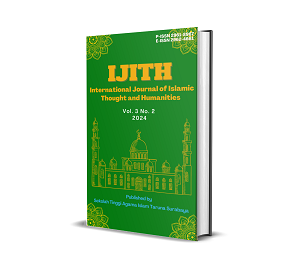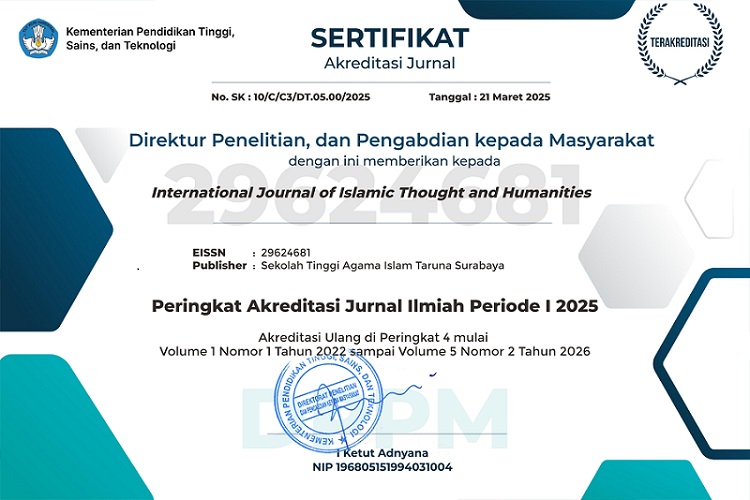Interpreting the Wali Songo Da'wah through Punokawan: Schleiermacher's Hermeneutical Study
DOI:
https://doi.org/10.54298/ijith.v3i2.481Keywords:
Hermeneutics of Intentionality, Punokawan, Semiotics, Da'wah CommunicationAbstract
Da'wah puppet skin The Punokawan is preaching, culturally packaged in the form of a symbol through traditional arts. Wayang figures are believed to have been created by the Walisongo as a medium for Islamic preaching in Java. In understanding these symbols, Friedrich DE Schleiermacher's hermeneutic approach is used, emphasizing the importance of the relationship between the reader, author, and text. Schleiermacher argued that to understand a text in its entirety; one must explore the psychological aspects and position of the author. Therefore, in interpreting the form of Punokawan, especially the figure of Semar, an understanding of the social, cultural, and spiritual context of Walisongo at that time is needed. This study employs the systematic literature review method, incorporating Schleiermacher's intentional hermeneutic approach, and is supported by Roland Barthes' semiotic Theory as a tool for analyzing symbols and signs. The results of the study indicate that the interpretation of the Semar character has not been based entirely on the values of Islamic preaching, which are the basis of its creation. Thus, this study aims to provide a deeper understanding of the preaching message contained in Punokawan, a legacy of Walisongo's symbolic communication.
Downloads
References
Abdullah, M. A. (2006). Islam dan Ilmu Pengetahuan: Menyandarkan Epistemologi Islam pada Konteks Sosial Budaya. Tiara Wacana.
Andani, S. (2023). Filosofi Gunungan dalam Pagelaran Wayang Kulit Ditinjau dari Perspektif Islam. ANWARUL, 3(4). https://doi.org/https://doi.org/10.58578/anwarul.v3i4.1519
Arifin, M. Z. (2019). Rekonstruksi simbol keislaman dalam wayang kulit. Universitas Islam Negeri Sunan Kalijaga Yogyakarta.
Azra, A. (2004). Islam Substansial: Makna dan Tujuan Hidup Meragama. Mizan.
Behrend, J. A. A. (1985). The Wayang Perfomance and Symbolism in Javanese Society. Lembaga Ilmu Pengetahuan Indonesia.
Cahyono, D. (2017). Punokawan sebagai media kritik sosial dalam wayang kulit. Jurnal Komunikasi Dan Budaya, 5(2).
Dhofier, Z. (1982). The Pesantren Tradition: The Role of the Kyai in the Maintenance of Traditional Islam in Java. Arizona State University.
Faiz, F. (2021). Mati Sebelum Mati: Buka Kesadaran Hakiki. Bentang Pustaka.
Fic, V. M. (2003). The Role of Indian Minorities in Burma and Indonesia. Abhinav Publications.
Horgan, M. L. Knapp; J. A. H. T. G. (2013). Nonverbal Communication in Human Interaction. Wadsworth Cengage Learning.
Khotimah, R. F. K. (2023). Persepsi masyarakat Jawa tentang pementasan wayang sebagai media dakwah Islam. At-Thariq: Jurnal Studi Islam Dan Budaya, 3(1).
Kurniawan. (2001). Semiologi Roland Barthes. Indonesia Tera.
Mahdaniar, A. S. F. (2024). Peta Teori Hermeneutika dan Implikasinya dalam Komunikasi Dakwah. Bil-Hikmah: Jurnal Komunikasi Dan Penyiaran Islam, 2(1). https://doi.org/10.55372/bilhikmahjkpi.v2i1.23
Mulder, N. (1999). Mysticism in Java: Ideology in Indonesia. Kanisius.
Nugroho, S. (2020). Nilai-nilai Spiritual Panakawan Wayang Kulit Purwa bagi Kehidupan Berbangsa dan Bernegara. Surakarta. Institut Seni Indonesia (ISI) Surakarta.
Ricklefs, M. C. (2008). A History of Modern Indonesia Since c.1200. Stanford University Press.
Riyadi, S. (2015). Makna Filsafat dalam Tokoh Punakawan Wayang Kulit. Jurnal Filsafat, 25(1).
Schleiemacher, F. (1998). Hermeneutics and Criticism and Other Writings (Edited and translated by Andrew Bowie). Cambridge University Press.
Snyder, H. (2019). Literature review as a research methodology: An overview and guidelines. Journal of Business Research, 104. https://doi.org/https://doi.org/10.1016/j.jbusres.2019.07.039
Wahid, M. (2011). Islam Nusantara: Sejarah Sosial Intelektual Islam di Indonesia. LKiS.
Woodward, M. R. (1989). Islam in Java: Normative Piety and Mysticism in the Sultanate of Yogyakarta. University of Arizona Press.
Downloads
Published
How to Cite
Issue
Section
License
Copyright (c) 2024 iga nurrohmatillah, Jupri Bandang Prawirodigdoyo Kusumonagoro, Luthfi Hidayah, Selvia Assoburu

This work is licensed under a Creative Commons Attribution-ShareAlike 4.0 International License.
Authors who publish with this journal agree to the following terms:
- Authors retain copyright and grant the journal right of first publication with the work simultaneously licensed under a Creative Commons Attribution-ShareAlike 4.0 that allows others to share the work with an acknowledgement of the work's authorship and initial publication in this journal.
- Authors are able to enter into separate, additional contractual arrangements for the non-exclusive distribution of the journal's published version of the work (e.g., post it to an institutional repository or publish it in a book), with an acknowledgement of its initial publication in this journal.
- Authors are permitted and encouraged to post their work online (e.g., in institutional repositories or on their website) prior to and during the submission process, as it can lead to productive exchanges, as well as earlier and greater citation of published work (See The Effect of Open Access).


















